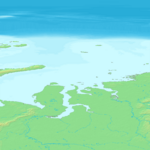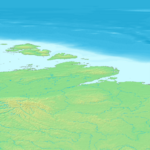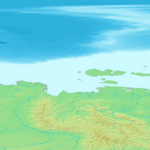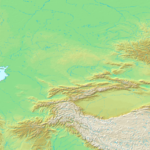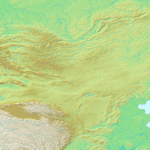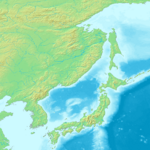Siberia

Siberia (Russian: Сиби́рь, Sibir'), is the name given to the vast region constituting almost all of Northern Asia and for the most part currently serving as the massive central and eastern portion of the Russian Federation, having served in the same capacity previously for the U.S.S.R. from its beginning, and the Russian Empire beginning in the 16th century. Geographically, it includes a large part of the Eurasian Steppe and extends eastward from the Ural Mountains to the watershed between Pacific and Arctic drainage basins, and southward from the Arctic Ocean to the hills of north-central Kazakhstan and the national borders of both Mongolia and China.[1] It makes up about 77% of Russia's territory (13.1 million square kilometres), but only 30% of Russia's population (42.2 million people).
Contents |
Origin of the name
Some sources[2] say that it originates from the Turkic for "sleeping land." Another version is that this name was the tribal name of the Sibilla, Turkic nomads later assimilated to Siberian Tatars. Dr. Pamela Kyle Crossley, a professor of history at Dartmouth College, asserts that the Russians named Siberia after the Sibe/Xibe. Shaman Akkanat, one of the last shaman in Western Siberia and a leading figure in the indigenous society in Western Siberia, said that Siberia got its name from his Nation, the Sibirga people. The modern usage of the name appeared in the Russian language after the conquest of the Siberia Khanate.
Borders and administrative division


The term Siberia has a very long history, and its meaning has gradually changed during ages. Historically, Siberia was defined as the whole part of Russia to the east of Ural Mountains, including the Russian Far East. According to this definition, Siberia extended eastward from the Ural Mountains to the Pacific coast, and southward from the Arctic Ocean to the border of Russian Central Asia and the national borders of both Mongolia (which included Tuva) and China.[3]
Soviet-era sources (GSE and others)[4] and modern Russian ones[5] usually define Siberia as a region extending eastward from the Ural Mountains to the watershed between Pacific and Arctic drainage basins, and southward from the Arctic Ocean to the hills of north-central Kazakhstan and the national borders of both Mongolia and China. Correspondingly, Siberia includes the federal subjects of the Siberian Federal District, and some of the Urals Federal District, as well as Sakha (Yakutia) Republic, which is a part of the Far Eastern Federal District. This definition also includes geographically (but not administratively) subdivisions of several other subjects of Urals and Far Eastern federal districts. This definition excludes Sverdlovsk Oblast and Chelyabinsk Oblast, both of which are included in some wider definitions of Siberia.
Other sources may use either a somewhat wider definition that states the Pacific coast, not the watershed, is the eastern boundary (thus including the whole Russian Far East)[6] or a somewhat narrower one that confines Siberia to the Siberian Federal District (thus excluding all subjects of other districts).[7] However, in Russian the word Siberia is never used to substitute the name of the federal district.
| subject | administrative center |
|---|---|
| Urals Federal District | |
| Khanty-Mansi Autonomous Okrug | Khanty-Mansiysk |
| Kurgan Oblast | Kurgan |
| Tyumen Oblast | Tyumen |
| Yamalo-Nenets Autonomous Okrug | Salekhard |
| Siberian Federal District | |
| Altai Krai | Barnaul |
| Altai Republic | Gorno-Altaysk |
| Buryat Republic | Ulan-Ude |
| Chita Oblast | Chita |
| Irkutsk Oblast | Irkutsk |
| Republic of Khakassia | Abakan |
| Kemerovo Oblast | Kemerovo |
| Krasnoyarsk Krai | Krasnoyarsk |
| Novosibirsk Oblast | Novosibirsk |
| Omsk Oblast | Omsk |
| Tomsk Oblast | Tomsk |
| Tuva Republic | Kyzyl |
| Far Eastern Federal District | |
| Sakha (Yakutia) Republic | Yakutsk |
| subject | administrative center |
|---|---|
| Far Eastern Federal District | |
| Amur Oblast | Blagoveshchensk |
| Chukotka Autonomous Okrug | Anadyr |
| Jewish Autonomous Oblast | Birobidzhan |
| Kamchatka Krai | Petropavlovsk-Kamchatsky |
| Khabarovsk Krai | Khabarovsk |
| Magadan Oblast | Magadan |
| Primorsky Krai | Vladivostok |
| Sakhalin Oblast | Yuzhno-Sakhalinsk |
| Urals Federal District | |
| Chelyabinsk Oblast | Chelyabinsk |
| Sverdlovsk Oblast | Yekaterinburg |
Major cities include:
- Barnaul
- Irkutsk
- Kemerovo
- Krasnoyarsk
- Novokuznetsk
- Novosibirsk
- Omsk
- Tomsk
- Tyumen
History
Siberia was occupied by differing groups of nomads such as the Yenets, the Nenets, the Huns, the Iranian Scythians, and the Turkic Uyghurs. The Khan of Sibir in the vicinity of modern Tobolsk was known as a prominent figure who endorsed Kubrat as Khagan in Avaria in 630. The area was conquered by the Mongols in the 13th century and eventually became the autonomous Siberia Khanate.
The growing power of Russia to the west began to undermine the Khanate in the 16th century. First, groups of traders and Cossacks began to enter the area, and then the Russian army began to set up forts further and further east. Towns like Mangazeya, Tara, Yeniseysk, and Tobolsk sprang up, the latter being declared the capital of Siberia. By the mid-17th century, the Russian-controlled areas had been extended to the Pacific.
Siberia remained a mostly undocumented and sparsely populated area. During the following few centuries, only a few exploratory missions and traders entered Siberia. The other group that was sent to Siberia consisted of prisoners exiled from western Russia or Russian-held territories like Poland (see katorga). In the 19th century, around 1.2 million prisoners were deported to Siberia.[8]
The first great modern change to Siberia was the Trans-Siberian railway, constructed in 1891–1916. It linked Siberia more closely to the rapidly-industrializing Russia of Nicholas II. Siberia is filled with natural resources and during the 20th century large scale exploitation of these was developed, and industrial towns cropped up throughout the region.
Katorga and Gulag
- Further information: Population transfer in the Soviet Union
Russia, later the Soviet Union, operated a series of labor camps, known as the GULAG,[9] which is an acronym for Main Camp Administration. They became so common that "Siberia" came to be used as metaphor for exile and punishment: "a bureaucratic Siberia" [10] Soviet authorities deported millions of people, including entire nationalities,[11] from western areas of the USSR to Central Asia and Siberia.[12]
By analogy, one working-class district of downtown Stockholm, Sweden, earned the name Sibirien (Siberia) in the late 19th century, referring to its low-cost tenement houses being built in outlying areas.
Geography and geology
|
|
|
|
|
Urals Federal District
Irtysh
Syr Darya
Tibetan
|
|
|
| physical map of Northern Asia | ||
|---|---|---|
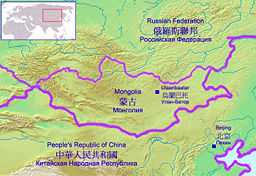
- Further information: Geography of Russia
With an area of 13.1 million km² (5.1 million square miles), Siberia makes up roughly 77% of the total area of Russia. Major geographical zones include the West Siberian Plain and the Central Siberian Plateau. Note that Siberia covers almost 10% of all land surface (148,940,000 km²) of our planet.
The West Siberian Plain consists mostly of Cenozoic alluvial deposits and is extraordinarily low-lying, so much so that a sea level rise of fifty metres would cause all land between the Arctic Ocean and Novosibirsk to be inundated. Many of the deposits on this plain result from ice dams; having reversed the flow of the Ob and Yenisei Rivers, so redirecting them into the Caspian Sea (perhaps the Aral as well). It is very swampy and soils are mostly peaty Histosols and, in the treeless northern part, Histels. In the south of the plain, where permafrost is largely absent, rich grasslands that are an extension of the Kazakh Steppe formed the original vegetation (almost all cleared now).
The Central Siberian Plateau is an extremely ancient craton (sometimes named Angaraland) that formed an independent continent before the Permian (see Siberia (continent)). It is exceptionally rich in minerals, containing large deposits of gold, diamonds, and ores of manganese, lead, zinc, nickel, cobalt and molybdenum. Much of the area includes the Siberian Traps which is a large igneous province. The massive eruptive period was approximately coincident with the Permian-Triassic extinction event. The volcanic event is said to be the largest known volcanic eruption in Earth history. Only the extreme northwest was glaciated during the Quaternary, but almost all is under exceptionally deep permafrost and the only tree that can thrive, despite the warm summers, is the deciduous Siberian Larch (Larix sibirica) with its very shallow roots. Outside the extreme northwest, the taiga is dominant. Soils here are mainly Turbels, giving way to Spodosols where the active layer becomes thicker and the ice content lower.
Eastern and central Sakha comprise numerous north-south mountain ranges of various ages. These mountains extend up to almost three thousand metres in elevation, but above a few hundred metres they are almost completely devoid of vegetation. The Verkhoyansk Range was extensively glaciated in the Pleistocene, but the climate was too dry for glaciation to extend to low elevations. At these low elevations are numerous valleys, many of them deep, and covered with larch forest except in the extreme north, where tundra dominates. Soils are mainly Turbels and the active layer tends to be less than a meter deep except near rivers.
The highest point in Siberia is the active volcano Klyuchevskaya Sopka, in the Kamchatka peninsula.
Climate
The climate of Siberia varies dramatically. On the north coast, north of the Arctic Circle, there is just a very short (about one-month-long) summer.
 |
|
polar desert tundra alpine tundra taiga montane forest |
| Vegetation in Siberia is mostly taiga, with a tundra belt on the northern fringe, and a temperate forest one in the south. |
Almost all the population lives in the south, along the Trans-Siberian railroad. The climate here is continental subarctic (Koppen Dfc or Dwc), with the annual average temperature about 0 ℃ (32 ℉) and roughly −15 ℃ (5 ℉) average in January and +20 ℃ (68 ℉) in July.[13] With a reliable growing season, an abundance of sunshine and exceedingly fertile chernozem soils, Southern Siberia is good enough for profitable agriculture, as was proven in the early twentieth century.
The southwesterly winds of Southern Siberia bring warm air from Central Asia and the Middle East. The climate in West Siberia (Omsk, Novosibirsk) is several degrees warmer than in the East (Irkutsk, Chita). With a lowest record temperature of −71.2 ℃ (−96.2 ℉), Oymyakon (Sakha Republic) has the distinction of being the coldest town on Earth. But summer temperatures in other regions reach 38 ℃ (100.4 ℉). In general, Sakha is the coldest Siberian region, and the basin of the Yana River has the lowest temperatures of all, with permafrost reaching 1,493 meters (4,898 ft). Nevertheless, as far as Imperial Russian plans of settlement were concerned, cold was never viewed as an issue. In the winter, southern Siberia sits near the center of the semi-permanent Siberian High, so winds are usually light in the winter.
Precipitation in Siberia is generally low, exceeding 500 millimeters (20 in) only in Kamchatka where moist winds flow from the Sea of Okhotsk onto high mountains – producing the region's only major glaciers – and in most of Primorye in the extreme south where monsoonal influences can produce quite heavy summer rainfall. Despite the region's notorious cold, snowfall is generally extremely light, especially in the east of the region.
Lakes and rivers
- Anabar River
- Angara River
- Indigirka River
- Irtysh River
- Kolyma River
- Lake Baikal
- Lena River
- Novosibirsk Reservoir
- Ob River
- Popigay River
- Tunguska River
- Upper Angara River
- Uvs Nuur
- Yana River
- Yenisei River
Mountain ranges
- Altay Mountains
- Anadyr Range
- Baikal Mountains
- Chamar-Daban
- Chersky Range
- Dzhugdzhur Mountains
- Gydan Mountains
- Koryak Mountains
- Sayan Mountains
- Tannu-Ola Mountains
- Ural Mountains
- Verkhoyansk Mountains
- Yablonoi Mountains
Grasslands
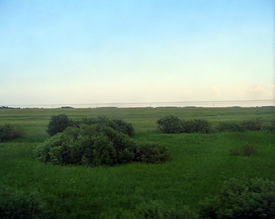
- Ukok Plateau — part of a UNESCO World Heritage Site[14]
Economy
Siberia is extraordinarily rich in minerals, containing ores of almost all economically valuable metals—largely because of the absence of Quaternary glaciation outside highland areas. It has some of the world's largest deposits of nickel, gold, lead, coal, molybdenum, gypsum, diamonds, silver and zinc, as well as extensive unexploited resources of oil and natural gas. Most of these are in the cold and remote eastern part of the region, with the result that extraction has proven difficult and began on a large scale only after Stalin came to power and developed labor camps to deal with the difficulty of attracting labour to such unpleasant climates.
Agriculture is severely restricted by the short growing season of most of the region. However, in the southwest where soils are exceedingly fertile black earths and the climate is a little more moderate, there is extensive cropping of wheat, barley, rye and potatoes, along with the grazing of large numbers of sheep and cattle. Elsewhere food production, owing to the poor fertility of the podzolic soils and the extremely short growing seasons, is restricted to the herding of reindeer in the tundra — which has been practised by natives for over ten thousand years. Siberia has the world's largest forests. Timber remains an important source of revenue despite the fact that many forests in the east have been logged much more rapidly than they are able to recover. The Sea of Okhotsk is one of the two or three richest fisheries in the world owing to its cold currents and extremely large tidal ranges, and thus Siberia produces over 10 percent of the world's annual fish catch, though fishing has declined somewhat since the collapse of the USSR.
Industry, developed during the interwar period (1920s and 1930s) and increased vastly during World War II, has declined greatly since the collapse of the USSR. At one point there were huge factories in Western Siberia and many even around Lake Baikal but these have largely ceased operation since the USSR collapsed.
Demographics
Siberia has population density of about three people per square kilometer. Most Siberians are Russians and Russified Ukrainians. Ethnic Russians are descended from Slavs who lived in Eastern Europe several hundred years ago. There are approximately 400,000 ethnic Germans living in Siberia.[15] Such Mongol and Turkic groups as Buryats, Tuvinians, Yakuts, and Siberian Tatars[16] lived in Siberia originally, and descendants of these peoples still live there.[17] Other ethnic groups include Kets, Evenks, Chukchis, Koryaks, and Yukaghirs. See the Northern indigenous peoples of Russia article for more. There are an estimated one million Chinese and over 55,000 Sakhalin Koreans in the Russian Far East.[18]
About 70% of Siberia's people live in cities. Most city people live in apartments. Many people in rural areas live in simple, but more spacious, log houses. Novosibirsk is the largest city in Siberia, with a population of about 1.5 million. Tobolsk, Tomsk, Krasnoyarsk, Irkutsk and Omsk are the older, historical centers.
Religion
There are a variety of beliefs throughout Siberia including Orthodox Christianity, Islam, Tibetan Buddhism, and denominations of Christianity.[19] An estimated 70,000 Jews live in Siberia.[20] The predominant group is the Russian Orthodox Church. However, native religion dates back hundreds of years. The vast terrority of Siberia has many different local traditions of gods. These include: Ak Ana, Anapel, Bugady Musun, Kara Khan, Khaltesh-Anki, Kini'je, Ku'urkil, Nga, Nu'tenut, Numi-Torem, Numi-Turum, Pon, Pugu, Todote, Toko'yoto, Tomam, Xaya Iccita, Zonget. Places with sacred areas include Olkhon, an island in Lake Baikal.
Transport
Many cities in Siberia, such as Petropavlovsk-Kamchatsky, can not be reached by road from other major cities in Russia or Asia. The best way to tour Siberia is through the Trans-Siberian Railway. The Trans-Siberian Railway operates from Moscow in the West to Vladivostok in the East. The train has 2nd class 4-berth compartments, 1st class 2-berth compartments, and a restaurant car. Cities not nearby the Railway are best reached by air.
Famous people born in Siberia
- Grigori Rasputin, Russian mystic, born a peasant in the small village of Pokrovskoye, in the Tobolsk guberniya (now Tyumen Oblast)
- Konstantin Chernenko, General Secretary of the CPSU, who led the Soviet Union in 1984–1985, was born in the village of Bolshaya Tes (disappeared under the waters of the Krasnoyarsk Reservoir, now in Novosyolovsky District, Krasnoyarsk Krai) in 1911.
- Yul Brynner, Russian-born American actor of stage and film, born in Vladivostok in 1920
- Boris Yeltsin, the first President of the Russian Federation, serving from 1991 to 1999, born in the village of Butka, in Talitsky District of Sverdlovsk Oblast, in 1931
- Sergei Bodrov, Academy Award nominated Russian filmmaker, born in Khabarovsk, in 1948, living in Los Angeles, USA
- Julia Neigel, Russian-German, musician, singer-songwriter, born in Barnaul, in 1966, April 19, living in Ludwigshafen am Rhein, Germany, since 1971
- Maxim Vengerov, Israeli violinist, born in Novosibirsk, in 1974
- Mark Holiday, Russian-American, producer, musician, singer-songwriter, born in Irkutsk, in 1988, June 5, living in Miami, USA, since 2008
See also
- Education in Siberia
- Russian conquest of Siberia
- Siberian nationalism
References
- ↑ Great Soviet Encyclopedia (in Russian)
- ↑ Healing oils from pristine Siberian wilderness
- ↑ Малый энциклопедический словарь Брокгауза и Ефрона (The Brockhaus and Efron Encyclopedic Dictionary, in Russian)
- ↑ Сибирь—Большая советская энциклопедия (The Great Soviet Encyclopedia, in Russian)
- ↑ Сибирь- Словарь современных географических названий (in Russian)
- ↑ Siberia--Britannica online encyclopedia
- ↑ Siberia--The Columbia Encyclopedia, Sixth Edition.
- ↑ Carl De Keyzer, Zona at the Impressions Gallery, BBC
- ↑ The Gulag Collection: Paintings of Nikolai Getman
- ↑ What Became of the CIA?, by Gabriel Schoenfeld. Also see this
- ↑ Deported Nationalities
- ↑ Anne Applebaum -- Gulag: A History Intro
- ↑ Historical Weather for Novosibirsk, Russia. weatherbase.com Last accessed November 6, 2006.
- ↑ "Altai: Saving the Pearl of Siberia". Retrieved on 2006-11-30.
- ↑ Siberian Germans
- ↑ According to the 2002 census there are 500,000 Tatars in Siberia, but 300,000 of them are Volga Tatars who settled in Siberia during periods of colonization.[1]
- ↑ Ethnographic map of Siberia
- ↑ Chinese Come To Russia
- ↑ Russian Embassy website — Religion in Russia
- ↑ Planting Jewish roots in Siberia
External links
- Siberia travel guide from Wikitravel
- The Green Tower, Siberia
- Siberian Expedition website, by Benjamin Isitt
- Siberia, article in Encarta Encyclopedia
|
||||||||||||||||||||||||||||||||||||
